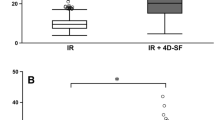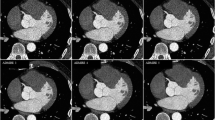Abstract
Objectives
To evaluate a new iterative reconstruction (IR) algorithm for radiation dose, image quality (IQ), signal-to-noise-ratio (SNR), and contrast-to-noise-ratio (CNR) in multidetector computed tomography (MDCT) dynamic myocardial perfusion imaging (MPI).
Methods
ECG-gated 256-slice MDCT dynamic MPI was performed in six pigs after subtotal balloon occlusion of one artery. Two 100 kVp protocols were compared: high dose (HD): 150 mAs; low dose (LD): 100 mAs. HD images were reconstructed with filtered back projection (FBP), LD images with FBP and different strengths of IR (L1, L4, and L7). IQ (5-point scale), SNR, and CNR (ischemic vs. normal myocardium) values derived from the HD (FBP) images and the different LD images were compared.
Results
Mean SNR values for myocardium were 16.3, 11.3, 13.1, 17.1, and 28.9 for the HD, LD (FBP), LD (L1), LD (L4), and LD (L7) reconstructions, respectively. Mean CNR values were 8.9, 6.3, 7.8, 9.3, and 12.8. IQ was scored as 4.6, 3.3, 4.4, 4.7, and 3.4, respectively. A significant loss of IQ was observed for the LD (L7) images compared to the HD (FBP) images (P < 0.05).
Conclusion
Appropriate levels of iterative reconstruction can improve SNR and CNR, facilitating radiation dose savings in CT-MPI without influencing diagnostic quality.
Key Points
• Iterative reconstruction (IR) can reduce radiation dose in myocardial perfusion CT.
• Our study also demonstrated improvements in image quality (noise, SNR, and CNR).
• Dynamic CT-MPI could help determine the hemodynamic significance of coronary artery disease.
• With dynamic CT MPI, myocardial blood flow can be determined quantitatively.





Similar content being viewed by others
Abbreviations
- CCTA:
-
Coronary CT angiography
- CNR:
-
Contrast-to-noise ratio
- CT:
-
Computed tomography
- FBP:
-
Filtered back projection
- HD:
-
High dose
- IQ:
-
Image quality
- IR:
-
Iterative reconstruction
- LD:
-
Low dose
- MDCT:
-
Multidetector CT
- MPI:
-
Myocardial perfusion imaging
- ROI:
-
Region of interest
- SNR:
-
Signal-to-noise ratio
References
Berrington de González A, Mahesh M, Kim KP et al (2009) Projected cancer risks from computed tomographic scans performed in the United States in 2007. Arch Intern Med 169:2071–2077
Gerber TC, Kantor B, Mc Collough CH (2009) Radiation dose and safety in cardiac computed tomography. Cardiol Clin 27:665–677
Leipsic J, LaBounty TM, Heilbron B et al (2010) Adaptive statistical iterative reconstruction: assessment of image noise in coronary CT angiography. AJR Am J Roentgenol 195:649–654
Knesaurek K, Machac J, Vallabhajosula S, Buchsbaum MS (1996) A new iterative reconstruction technique for attenuation correction in high-resolution positron emission tomography. Eur J Nucl Med 23:656–661
Thibault JB, Sauer KD, Bouman CA, Hsieh J (2007) A three-dimensional statistical approach to improved image quality for multislice helical CT. Med Phys 34:4526–4544
Gervaise A, Osemont B, Lecocq S, et al (2012) CT image quality improvement using adaptive iterative dose reduction with wide-volume acquisition on 320-detector CT. Eur Radiol 22:295–301
Bittencourt MS, Schmidt B, Seltmann M et al (2011) Iterative reconstruction in image space (IRIS) in cardiac computed tomography: initial experience. Int J Cardiovasc Imaging 27:1081–1087
Marin D, Nelson RC, Schindera ST et al (2010) Low-tube-voltage, high-tube-current multidetector abdominal CT: improved image quality and decreased radiation dose with adaptive statistical iterative reconstruction algorithm—initial clinical experience. Radiology 254:145–153
Heilbron BG, Leipsic J (2010) Submillisievert coronary computed tomography angiography using adaptive statistical iterative reconstruction—a new reality. Can J Cardiol 25:35–36
Halliburton SS (2009) Recent technologic advances in multi-detector row cardiac CT. Cardiol Clin 27:655–664
Hara AK, Paden RG, Silva AC, Kujak JL, Lawder HJ, Pavlicek W (2009) Iterative reconstruction technique for reducing body radiation dose at CT: feasibility study. AJR Am J Roentgenol 193:764–771
Prakash P, Kalra MK, Digumarthy SR et al (2010) Radiation dose reduction with chest computed tomography using adaptive statistical iterative reconstruction technique: initial experience. J Comput Assist Tomogr 34:40–45
Silva AC, Lawder HJ, Hara A, Kujak J, Pavlicek W (2010) Innovations in CT dose reduction strategy: application of adaptive statistical iterative reconstruction algorithm. AJR Am J Roentgenol 194:191–199
Noel PB, FIngerle AA, Renger B, Muenzel D, Rummeny EJ, Dobritz M (2011) Initial performance characterization of a clinical noise-suppressing reconstruction algorithm for MDCT. AJR Am J Roentgenol 197:1494–1409
Hosch W, Stiller W, Mueller D et al (2011) Reduction of radiation exposure and improvement of image quality with BMI-adapted prospective cardiac computed tomography and iterative reconstruction. Eur Radiol Jun 29. [Epub ahead of print]
Muenzel D, Noel PB, Dorn F, Dobritz M, Rummeny EJ, Huber A (2010) Coronary CT angiography in step-and-shoot technique with 256-slice CT: impact of the field of view on image quality, carniocaudal coverage, and radiation exposure. Eur J Radiol. doi:10.1016/j.ejrad.2011.06.055. Accessed 21 Nov 2011
Stolzmann P, Scheffel H, Schertler T et al (2008) Radiation dose estimates in dual source computed tomography coronary angiography. Eur Radiol 18:592–599
Morhard D, Wirth CD, Fesl G et al (2010) Advantages of extended brain computed tomography: 9.6 cm coverage with time resolved computed tomography-angiography in comparison to standard stroke-computed tomography. Invest Radiol 45:363–369
Bamberg F, Becker A, Schwarz F et al (2011) Detection of hemodynamically significant coronary artery stenosis: incremental diagnostic value of dynamic CT-based myocardial perfusion imaging. Radiology 260:689–698
Bamberg F, Hinkel R, Schwarz F, Sandner TA et al (2012) Accuracy of dynamic computed tomography adenosine stress myocardial perfusion imaging in estimating myocardial blood flow at various degrees of coronary artery stenosis using a porcine animal model. Invest Radiol 47:71–77
Bamberg F, Koltz E, Flohr T et al (2010) Dynamic myocardial stress perfusion imaging using fast dual-source CT with alternating table positions: initial experience. Eur Radiol 20:1168–1173
Mahnken AH, Klotz E, Pietsch H et al (2010) Quantitative whole heart stress perfusion CT imaging as noninvasive assessment of hemodynamics in coronary artery stenosis: preliminary animal experience. Invest Radiol 45:298–305
McCollough CH, Bruesewitz MR, Kofler JM Jr (2006) CT dose reduction and dose management tools: overview of available options. Radiographics 26:503–512
Jakobs TF, Becker CR, Ohnesorge B et al (2002) Multislice helical CT of the heart with retrospective ECG gating: reduction of radiation exposure by ECG-controlled tube current modulation. Eur Radiol 12:1081–1086
Abada HT, Larchez C, Daoud B, Sigal-Cinqualbre A, Paul JF (2006) MDCT of coronary arteries: feasibility of low-dose CT with ECG-pulsed tube current modulation to reduce radiation dose. AJR Am J Roentgenol 186:387–390
Achenbach S, Giesler T, Ropers D et al (2003) Comparison of image quality in contrast-enhanced coronary-artery visualization by electron-beam tomography and retrospectively electrocardiogram-gated multislice spiral computed tomography. Invest Radiol 38:119–128
Hausleiter J, Meyer T, Hadamitzky M et al (2006) Radiation dose estimates from cardiac multislice computed tomography in daily practice: impact of different scanning protocols on effective dose estimates. Circulation 113:1305–1310
Hsieh J, Londt J, Vass M, Li J, Tang X, Okerlund D (2006) Step-and-shoot data acquisition and reconstruction for cardiac x-ray computed tomography. Med Phys 33:4236–4228
Shuman WP, Branch KR, May JM et al (2008) Prospective versus retrospective ECG gating for 64-detector CT of coronary arteries: comparison on image quality and patient radiation dose. Radiology 248:424–430
Pontone G, Andreini D, Bartorelli AL et al (2009) Diagnostic accuracy of coronary computed tomography angiography: a comparison between prospective and retrospective electrocardiogram triggering. J Am Coll Cardiol 54:346–355
Klass O, Jeltsch M, Feuerlein S et al (2009) Prospectively gated axial CT coronary angiography: preliminary experiences with a novel low-dose technique. Eur Radiol 19:829–836
Park EA, Lee W, Kang JH, Yin YH, Chung JW, Park JH (2009) The image quality and radiation dose of 100-kVp versus 120-kVp ECG-gated 16-slice CT coronary angiography. Korean J Radiol 10:235–243
Dorn F, Muenzel D, Meier R, Poppert H, Rummeny EJ, Huber A (2011) Brain perfusion CT for acute stroke using a 256-slice CT: improvement of diagnostic information by large volume coverage. Eur Radio 21:1803–1810
Mahnken AH, Brunders P, Muehlenbruch G et al (2007) Low tube voltage improves computed tomography imaging of delayed myocardial contrast enhancement in an experimental acute myocardial infarction model. Invest Radiol 42:123–129
Singh S, Kalra MK, Gilman MD et al (2011) Adaptive statistical iterative reconstruction technique for radiation dose reduction in chest CT: a pilot study. Radiology 259:565–573
Leipsic J, Labounty TN, Heilbron B et al (2010) Estimated radiation dose reduction using adaptive statistical iterative reconstruction in coronary CT angiography; the ERASIR study. AJR Am J Roentgenol 195:655–660
Funama Y, Taguchi K, Utsunomiya D et al (2011) Combination of low-tube-voltage technique with hybrid iterative reconstruction (iDose) algorithm at coronary computed tomographic angiography. J Comput Assist Tomogr 35:480–485
Author information
Authors and Affiliations
Corresponding author
Rights and permissions
About this article
Cite this article
Gramer, B.M., Muenzel, D., Leber, V. et al. Impact of iterative reconstruction on CNR and SNR in dynamic myocardial perfusion imaging in an animal model. Eur Radiol 22, 2654–2661 (2012). https://doi.org/10.1007/s00330-012-2525-z
Received:
Revised:
Accepted:
Published:
Issue Date:
DOI: https://doi.org/10.1007/s00330-012-2525-z




